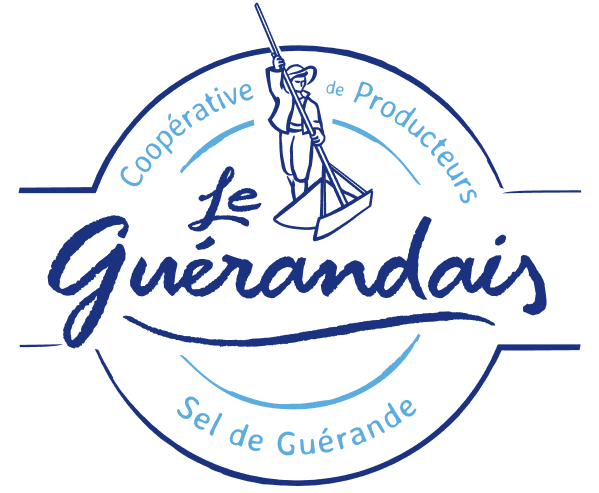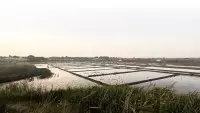
Étiers: definition and presentation
The birth of salt in the Guérande salt marshes is the perfect illustration of the magical encounter between water, sun and wind, but also the fruit of a skilful and precise process. A unique collaboration between Man and Nature.
All year round, from ocean to plate, seawater travels through the lands of Guérande, following the path of the étiers. It is a fundamental element in the creation of Le Guérandais Guérande Salt, essential to preserving its quality and safeguarding ancestral know-how.
Summary
What are the étiers used for?
By definition, an étier is "a channel that connects a coastal marsh with the sea at high tide".
Etiers are narrow channels sometimes several kilometers long. The vast majority of them are used to supply salt marshes with water from the ocean, but they can also be used as waterways, as separators between several agricultural plots, and as drainage channels for marsh water.
In salt marshes such as those of Guérande, étiers play a major role: they allow for proper management of seawater, which then enables the evaporation necessary for salt crystallization and harvesting.

The parallel between expression and the right amount of salt
Step 1: From ocean to étiers
The history of salt begins where water has its highest concentration of salt... In the Atlantic Ocean. Here, the water enters the Traict du Croisic before flowing up through a network of canals, the étiers, to reach the heart of the Guérande basin, located several kilometers from the coast.
Step 2: The passage through the vasière
During high tides and when he needs water, the salt worker opens a trap door to let seawater enter the vasière, the first evaporation basin. This basin also acts as a settling basin, where suspended particles brought in by the sea settle.
Step 3: Daily reserve basins
Thanks to a slight gradient, the water continues its journey towards the evaporation basins, which serve as daily reserves. These basins then feed the last basins where the salt is harvested, the œillets.
Step 4: Salt crystallization
It is finally in the œillets that the salt concentration reaches a sufficient level for the salt to crystallize (between 250 and 280 g/l). The salt worker must then adjust water levels to compensate for daily evaporation. This is how Le Guérandais salt came into being.
In the Guérande salt marshes, salt workers belonging to the Coopérative Le Guérandais produce and harvest 2 types of salt:
La Fleur de sel: Fleur de sel, also known as the white gold of the marshes, is harvested by hand from the surface of the water by salt workers using a unique know-how. It's a fine, elegant product with a subtle taste and a slight crunch.
Coarse salt: coarse salt, naturally grey due to the clay at the bottom of the œillets, is unwashed and ideal for cooking all kinds of recipes. It settles to the bottom of the carnations after evaporation and is harvested by hand by salt workers.
Etiers: a key element of the local heritage
All year round, the paludiers work in the marshes. Salt is harvested in summer, when the afternoons are warm and a light wind caresses the water in the salt marshes.
The rest of the year, the paludiers mobilize and maintain the salt marshes alone or collectively. It's in winter, after a slight slowdown in activity, that they tackle the upkeep and cleaning of the étiers, as well as repairs to any damage caused by the vagaries of autumn weather.
Etiers hold a special place in the lives of not only the paludiers, but also the inhabitants of Guérande. They fit perfectly into the local heritage, adorning the land and roadsides with their long silhouettes, while guaranteeing the production of exceptional salt. It is therefore essential to maintain them well in order to guarantee a quality salt produced according to a savoir-faire unique and ancestral, but also to honor the Guérande countryside and its inhabitants.
Le Guérandais Guérande Salt is 100% natural, unwashed, unbleached and unrefined. Each year, it is harvested by hand using ancestral methods by the paludiers who are members of the Cooperative in the Guérande salt marshes.
The ecological impact of étiers
Etiers also play a major role in the maintenance and balance of local salt marsh ecosystems, providing a home for specific fauna and flora such as algae, birds and micro-organisms essential to ecosystem health.
By regulating the inflow of water, étiers enable sustainable management of natural salt production, limiting environmental impact through the reasoned use of natural resources and requiring no fossil fuels or chemicals.
Paludiers and members of the Le Guérandais Cooperative have also always made it a point of honor to respect and preserve the land from harmful practices by banning the use of chemicals, maintaining hydraulic networks in undeveloped areas, and undertaking collective restoration and maintenance work on dykes.




